Because of the standardised shape and size of containers they can easily be placed above and next to each other and are able to connect via the corners with the addition of some extra security devices.
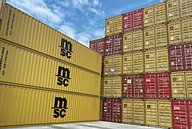
Stacking your containers means that you can double or even triple your storage capacity whilst using the same building footprint, improving the efficiency of your land by utilising all the available space. Bespoke offices, shops and restaurants can all be created by merging multiple containers, our own examples of which include STACK Newcastle, STACK Seaburn and our previous modular office.
How High Can Shipping Containers be Stacked?
There is no legal limit on the number of containers that can be stacked on land, but it goes without saying that reasonable caution should always be exercised whilst planning and actioning your stacking venture.
Although there is no height restriction, there is however a maximum bearing load, which can be found on the CSC plate of the container. This displays the total weight that the container can withstand and must be followed.
Here at Cleveland Containers, we stack the containers at our depots no more than 5-high. These will also be stacked incrementally higher in rows, so the first row will be 3-high, followed by 4-high and then finally 5-high. This makes the container towers more stable in bad weather as the higher stacks are less likely to topple over in the wind because of the surrounding protection.
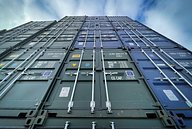
How are Shipping Containers Stacked Safely?
First thing’s first, you need to make sure the containers are free from any significant bumps or dents that could impact the structural integrity of the entire stack. Even if the CSC plate says otherwise, older containers with signs of damage may no longer have the strength or durability to withstand stacking. New (one trip) and wind and watertight units should be fine to use if they have been checked over beforehand.
When it comes to stacking them, like-sized containers need to be positioned corner-post to corner-post. Weight is distributed on these four points, which is why the posts are slightly taller than the roof of the container and come down slightly further than the floor of the container.
For example, if you had one 40ft container and two 20ft containers, you would need to place the 40ft on top as all four corner posts can be set on the posts underneath. You shouldn’t stack the 20ft containers on top as there would be no support for the posts in the middle and they could potentially fall through the roof of the container below. Bear this in mind if you are considering stacking units of differing lengths. It would also be dangerous to stack three or more containers by themselves as this would be a tall, narrow structure with a large flat area to catch wind and potentially fall.
One way that containers can be stacked is by using a forklift truck to move and situate them. It is vital that the forklift is navigated by a fully trained and certified operator. To further minimise the risks, everyone on site must stay clear of the area and take extra care and precaution whilst containers are being manoeuvred. A crane can also be used as an alternate method to place the containers, especially if forklifts are unable to reach the top.
It’s important to remember that containers should only be stacked on flat, solid ground, as a strong and stable foundation is needed to ensure they won’t sink or topple.
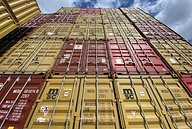
How Do You Secure Shipping Container Stacks?
There are a few simple and affordable accessories that can be installed to securely connect containers in place.
To fix the containers vertically you can use a device called a twist lock. These can be inserted into the corner castings of the top and bottom containers and rotated by 90 degrees to lock the units together.
Bridge fittings are similar and clamp containers that are next to each other horizontally through the corner castings.
How High Would You Suggest Stacking Containers If They Are Forming a Permanent Structure?
When it comes to bespoke builds intended for living, recreational, and working purposes, we would suggest going no more than two units high.
Two is likely to be a safe amount however the containers are arranged. Going three or more high will require significantly more modification work to make the final build structurally safe, and more extensive administrative tasks such as planning permission applications will need to be undertaken.
You should now have a better understanding of how to stack shipping containers safely and securely, but if you have any further questions about container stacking, contact us today for more information.
Need Our Help?
Talk to us about your shipping container project today...
You may also be interested in...

Can You Join Shipping Containers Together?
How do you join shipping containers together and what are the benefits of connecting them?
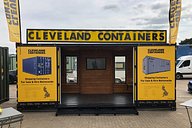
Why Choose A Side Opening Container?
Side opening shipping containers are an extremely useful option for businesses due to the increased access along the entire length, improving efficiency and conversion potential.

How to Clad a Shipping Container
Regardless of whether you purchase a new or used container, cladding can be a great way to disguise that your shipping container was ever built to transport goods at sea, instead, completing transforming your container aesthetically!




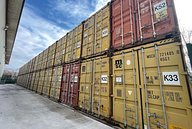



1 Comment
Please leave a comment using the form below
Castoravon
I especially appreciated how you didn't just dive into the technicalities, but also touched on the practical aspects, like safety regulations and the importance of proper planning. It really drives home the point that stacking containers isn't just about piling them up high; there's a whole science behind it. Thanks for shedding light on this topic in such a clear and engaging way. Looking forward to reading more from you!